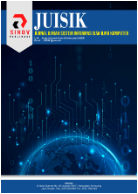Analisis Sentimen Media Sosial X Program Makanan Sehat Gratis dengan Support Vector Machine dan Naive Bayes
DOI:
https://doi.org/10.55606/juisik.v5i3.1665Keywords:
Free Nutritious Meals, Naïve Bayes, Sentiment Analysis, Social Media, SVMAbstract
The free nutritious meal program, has sparked various reactions from the public, particularly on social media. This study aims to determine how netizens feel about the program through data analysis from social media platform X (formerly Twitter). Data was collected using web scraping techniques with the keyword “free nutritious meals,” then processed through text cleaning and automatic labeling stages using the Indonesian language version of the RoBERTa model. With this approach, each tweet was efficiently and accurately classified into positive or negative sentiment. The labeled data was then analyzed using two classification algorithms: Support Vector Machine (SVM) and Naïve Bayes. Test results showed that SVM performed better, with an average accuracy of 0.8367 and a deviation of 0.0117. Meanwhile, Naïve Bayes recorded an accuracy of 0.7716 with a deviation of 0.0101. Visualization through WordCloud also shows the dominant words in each sentiment. Words such as “support,” “healthy,” and ‘grow’ appear frequently in positive sentiments, while words such as “budget,” “poison,” and “cost” dominate negative sentiments. These findings illustrate significant public support for the program, but also concerns regarding its implementation and funding. The results of this analysis are expected to provide input for policymakers in understanding public opinion more objectively
References
Atmajaya, D., Febrianti, A., & Darwis, H. (2023). Metode SVM dan Naive Bayes untuk analisis sentimen ChatGPT di Twitter. Indonesian Journal of Computer Science Attribution, 12(4), 2173–2181. https://doi.org/10.33022/ijcs.v12i4.3341
Ibrahim, V., Bakar, J. A., Harun, N. H., & Abdulateef, A. F. (2021). A word cloud model based on hate speech in an online social media environment. Baghdad Science Journal, 18(2), 937–946. https://doi.org/10.21123/bsj.2021.18.2(Suppl.).0937
Isnain, A. R., Sakti, A. I., Alita, D., & Marga, N. S. (2021). Sentimen analisis publik terhadap kebijakan lockdown pemerintah Jakarta menggunakan algoritma SVM. Jurnal Data Mining dan Sistem Informasi, 2(1), 31–37. https://doi.org/10.33365/jdmsi.v2i1.1021
Muallifa, R. N. L. (2025, January 6). Program makan bergizi gratis mulai kapan? Cek mekanismenya. Liputan6.com. https://www.liputan6.com/hot/read/5864880/program-makan-bergizi-gratis-mulai-kapan-cek-mekanismenya?page=2
Muallifa, R. N. L., Reni, S. D. I., dan Sugiarto, E. C. sudah termasuk sumber web, sehingga dapat dicatat dengan tanggal akses jika perlu untuk dokumen akademik.
Natasuwarna, A. P. (2020). Seleksi fitur support vector machine pada analisis sentimen keberlanjutan pembelajaran daring. Techno.Com, 19(4), 437–448. https://doi.org/10.33633/tc.v19i4.4044
Nugroho, K. S. (2019, November 13). Confusion matrix untuk evaluasi model pada supervised learning. https://ksnugroho.medium.com/confusion-matrix-untuk-evaluasi-model-pada-unsupervised-machine-learning-bc4b1ae9ae3f
Pratiwi, R. W., H, S. F., Af’idah, D. I., A, Q. R., & F, A. G. (2021). Analisis sentimen pada review skincare Female Daily menggunakan metode support vector machine (SVM). Journal of Informatics, Information System, Software Engineering and Applications, 4(1), 40–46. https://doi.org/10.20895/inista.v4i1.387
Rangga, N., & Hayaty, M. (2019). Perbandingan akurasi dan waktu proses algoritma K-NN dan SVM dalam analisis sentimen Twitter. Jurnal Informatika, 6(2), 212–218. https://doi.org/10.31311/ji.v6i2.5129
Reni Saptati, D. I. (2025). Pemerintah salurkan makan bergizi gratis (MBG), ini sasaran utama penerimanya. Media Keuangan. https://mediakeuangan.kemenkeu.go.id/article/show/pemerintah-salurkan-makan-bergizi-gratis-mbg-ini-sasaran-utama-penerimanya
Rusdiaman, D., & Rosiyadi, D. (2019). Analisa sentimen terhadap tokoh publik menggunakan metode Naïve Bayes Classifier dan Support Vector Machine. CESS (Journal of Computer Engineering System and Science), 4(2), 230–235. https://doi.org/10.24114/cess.v4i2.13796
Salsabila, N. A. (2022). Skripsi analisis sentimen pada media sosial Twitter terhadap tokoh Gus Dur menggunakan metode Naïve Bayes dan support vector machine (SVM).
Sembiring, F., & Sari, D. P. (2019). Design process data storage and organize data scraping. Integrated (Information Technology and Vocational Education), 1(1), 19–22. https://doi.org/10.17509/integrated.v1i1.16837
Simon Kemp. (2024, February 21). Digital 2024: Indonesia. Datareportal - Global Digital Insights. https://datareportal.com/reports/digital-2024-indonesia
Sugiarto, E. C. (2024, December 18). Makan bergizi gratis dan SDM unggul. Sekretariat Negara. https://www.setneg.go.id/baca/index/makan_bergizi_gratis_dan_sdm_unggul?utm_source=chatgpt.com
Tarale, H. (2025). Web scraping using Python. The Academic International Journal of Multidisciplinary Research, 3(1), 1023–1033. https://doi.org/10.5281/zenodo.14852767
Trisna, K. W. (2023). Model penerimaan pinjaman nasabah menggunakan algoritma Naïve Bayes dalam dataset bank. JBASE - Journal of Business and Audit Information Systems, 6(1), 1–13. https://doi.org/10.30813/jbase.v6i1.4309
Yondra, A. S., Triyanto, D., & Bahri, S. (2022). Implementasi web scraping untuk mengumpulkan informasi produk dari situs e-commerce dan marketplace dengan teknik pemrosesan paralel. Jurnal Komputer dan Aplikasi, 10(5), 93–102. https://doi.org/10.26418/coding.v10i01.52722
Zendrato, A. D., Berutu, S. S., Sumihar, Y. P., & Budiati, H. (2024). Pengembangan model klasifikasi sentimen dengan pendekatan VADER dan algoritma Naive Bayes terhadap ulasan aplikasi Indodax. Journal of Information System Research (JOSH), 5(3), 755–764. https://doi.org/10.47065/josh.v5i3.5050.
Downloads
Published
How to Cite
Issue
Section
License
Copyright (c) 2025 Jurnal ilmiah Sistem Informasi dan Ilmu Komputer

This work is licensed under a Creative Commons Attribution-ShareAlike 4.0 International License.










